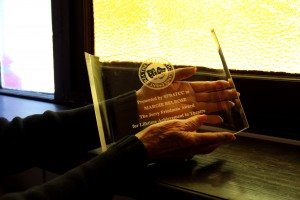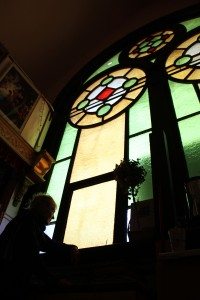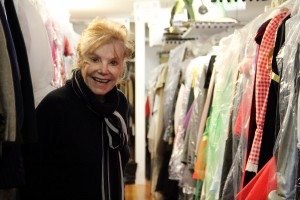by David Templeton
“Want to hear a great show biz story?”
Margie Belrose, perched on a chair inside the atmospheric, slightly mysterious interior of The Belrose performing arts center, knows better than most how to kick off a really good story.
“The best show biz stories,” Belrose says, “are about the right people being in the right place at the right time, right? Well … I’ve got a story like that, a story so good some people have accused me of making it up. But it’s all true. I swear it is.”
Belrose’s sweet smile and confident voice suggest that even if her story were not true, she’d be able to convince a person otherwise. It doesn’t hurt that Belrose is a certified local legend. Inducted into the Marin Women’s Hall of Fame in 1997, and named San Rafael’s Person of the Year in 2010, Belrose, 84, is also a recipient of the 2015 Jerry Friedman Lifetime Achievement Award—presented to her last March at the San Francisco Bay Area Theater Critics Circle gala ceremony. She was treated to a four-minute-long standing ovation by 300 critics, actors, directors and other practicing artists from the Bay Area theater community.

The ovation was in recognition of much more than just Belrose’s longevity. The theater and school that bears her name—which she founded with her late husband David in 1956 before moving to the current location—has been a small-but-mighty hub of theatrical energy for decades. Belrose estimates that more than 6,000 students of acting, dancing and other theatrical disciplines have graduated from the theater over the years. Though Belrose herself has had to take a break from teaching, dancing and directing after a serious back injury two years ago, San Rafael’s little downtown theater across from the library is still going strong. Weekly dance and exercise classes continue to take place there—everything from Tango to Tai Chi—and the theater has recently become the new home of Marin Onstage, which just had a successful run of the popular meta-musical called [Title of Show].
[That’s the title. Brackets included.]
Even this afternoon, as Belrose reminisces with a visitor, there is a constant bit of bustle in the space, as Johnny Smith, a regular producer of events at the Belrose, sets up for one of the fashionable afternoon teas he’s been putting on there for years.
“I hate the theater to be dark, I just hate it,” Belrose says. “Whether we make money or not—though that’s obviously important—I just don’t want the place to ever look like we’ve gone out of business—that this is a place where interesting things aren’t always happening.”
Which brings us back to the story. That’s the thing about Margie Belrose. Much like her life, her stories have many tangents.
“I’m an orphan,” she says. “It’s true. I was born in New Jersey, but my sister and I were raised in orphanages, at first in New Jersey, then in Saginaw and Detroit, in Michigan.”
After her mother abandoned the family when Belrose was a year old, her abusive father quickly followed suit, and the girls were turned over to a Protestant orphanage. After a series of moves, Belrose was transferred to a Catholic orphanage.
“It was good and it was bad,” she says with a shrug. “I’m not Catholic, but at one orphanage there was a nun who changed my life. Sister Theresa. I know she loved me. I know she did. Nobody ever looked at me the way she looked at me. She convinced me that I was worth loving, that my life was worth living. I thank her every morning.”
Though Belrose knew little about her parents, there is one thing that she has always known about herself.
“I’m a dancer,” she says firmly. “I remember being three years old, standing on this grassy hill, I’m not sure where—my memories of childhood have a lot of gaps in them—but I was dancing on this hill, and singing out loud, ‘I’m going to be a dancer! I’m going to be a dancer!’ I have no idea where I’d seen dancing to know about it, but I remember that so clearly, being a little girl who knew exactly what she wanted to be.”
By the time she became a freshman in high school, Belrose had explored every opportunity to dance available to a kid in “the system,” and finally began paying for formal dance lessons herself.
“A dance class was 50 cents a lesson back then,” she says. “So I scrounged and I saved and I found that 50 cents a week. Because one way or another, I was going to become a dancer. I just had to do it.” She started out loving ballet, but recalls that there wasn’t a single ballet lesson that she did not leave in tears. “In those days, the teacher gave you a whack if you did anything that wasn’t perfect. It wasn’t a happy thing. But I loved dancing ballet in spite of it.”
That said, Belrose eventually learned to tap dance, a dancing style she now claims as her favorite.
“I don’t think you can tap dance and be unhappy,” she says. “You can jazz dance and be unhappy. You can certainly do ballet and be unhappy. But the minute you start tap dancing, you just feel good!”
After being taken in by a foster family—one of the few other times she says she knew she was loved as a child—she ended up in California, where she eventually graduated, and then met David Belrose. A dancer with theatrical ambitions, the San Francisco State psychology grad shared his new wife’s dream of starting a school where they could teach others to believe in their own dreams of dancing and acting.
For a pair of young dreamers, it was an ambitious undertaking. After several years of operating out of whatever rental facility they could find, now with two children, a chance event occurred that Belrose still considers a miracle.
“It was one of those magical occurrences that some people don’t believe in, but I do,” she says. “We needed more space for our school, and we wanted to operate a real theater, too. And one night we walked past this place, which then was an old, empty church up for sale. And I said to David, ‘Look at that old church! That would be a perfect place for our school and theater.’”

The sign out front said Trinity Lutheran Church. It was formerly Saint Matthew’s German Evangelical Church, and had just recently been put up for rent. David was initially pessimistic about it being financially feasible to acquire such a place, but the idea would not leave Margie’s mind.
She eventually located the realtor, visited the facility and decided to take matters into her own hands.
“I had a lawyer friend, whose kids I’d been teaching to dance,” she says. “His name was Sol. His wife had said that if David and I ever wanted to invest our money, Sol was the guy to talk to. Well, we didn’t have a pot to piss in let alone money to invest in anything, but now I had an idea. One night I called up Sol—it was 9 o’clock at night—and I told him he had to meet me right then, that it was a matter that concerned the very lives of the Belrose family.”
He showed up at the church, where Belrose was waiting with a flashlight.
“The side door had been left open,” she says. “I knew because I was the one who left it open when I was in earlier with the owner. We looked all around, and I started pointing things out to Sol. ‘That’s where the stage will be! This is where the box office will be!’”
The next day, Belrose, her kids in tow, met Sol for lunch.
“I looked him square in the eyes and said, ‘Sol, that building belongs to the Belrose family. You have to help us get it and make this dream happen!’ and he just looked at me for a minute, kind of adjusted his collar, and said, ‘Well, if I HAVE to help … then I guess I will.’”
That was March of 1962, and by the summer of that year, the family had moved into an upstairs apartment in the church. The renovations had already begun, and the Belrose Theater was born.
“If it wasn’t for Sol, not only would we not have ended up with this theater, I’m certain this would be a parking lot now.”
Belrose stops, practically beaming with pleasure at the memory.
“Now,” she says, leaning in with a bright smile, “isn’t that a great show biz story?”
Fortunately for several thousand theater students and would-be actors, that wasn’t the end of the story. Almost immediately, David and Margie started producing shows on the new Belrose Stage. The first was an original show called Zig Zag, written by David, who went on to write many more plays for that stage.
“I named that first one Zig Zag, because it was a crazy thing where we had four different scenes that were totally different, so there was a scene and then it ‘zigged’ over to something else and then it ‘zagged’ off in yet another direction, and on like that,” Belrose recalls. “Zig Zag. I named all of our shows. It was fun!”
Then, in 1971, David Belrose died suddenly of a heart attack. It was then up to Margie to keep the theater going or move on to something else. She decided to stick it out and learn what she needed to learn to make the theater work.
“I have learned a lot in the last 40 years, I can tell you,” she says.
One thing she learned was, when you own your own theater, you can do more than just help other people’s dreams come true. You can allow yourself a few dreams of your own.
Which is why, in the mid-1970s, at the age of 40, Margie Belrose played Peter Pan in a production that became a kind of celebration of her new life.
“I thought I was too old,” she says. “I know David would have said I was too old. But a friend said, ‘Margie, this is YOUR theater. This is where you tell kids to take chances and try scary things. This is your turn. If you don’t do well with it, who cares? You should just do it. You want to be Peter Pan? Be Peter Pan!’
“I tell you,” she says, “that was a turning point in my professional life. We ended up doing two different productions of Peter Pan over the next few years.”
Since then, she’s appeared in several shows at the Belrose, including playing Queen Eleanor in seven different productions of the classic A Lion in Winter. In 1978, her son David opened a costume shop downstairs, an ever-expanding enterprise that has often been called one of Marin County’s greatest local treasures. Sometime after that, Belrose introduced the idea of doing dinner theater, adding yet another distinct attraction to The Belrose.

Two years ago, she decided to write a memoir—another scary project that she refused to back down from. The result is The Me I Found: A Journey, available at local bookstores. And of course, there are a few copies on sale at The Belrose.
Today, Margie Belrose looks forward to a time in the not-too-distant-future when she can get back to work—back to acting and back to teaching.
“I hurt too much right now; I’m too unstable,” she says. “But it won’t last. I’ll do it again. I’ll do what I have to do. And theater is just that—it’s what I have to do.”
Looking around the room, hung with the various paintings and decorations that she’s collected over the years, Belrose allows herself a moment to reflect on what her life would be like if she’d never taken that chance, never joined up with David to turn an old abandoned church into an icon of blind faith and big dreams.
She can’t imagine it.
“This is all I ever wanted,” she says. “A safe place to be myself in. The thing is, we didn’t just come in and here and sit around hoping something good would happen next. We came in with a plan, and we came in with a vision, and we came in believing we were the only ones who could make it happen.
“And then we did it.”
Margie Belrose, leaning in again, lets another mischievous smile spread across her face.
“So there,” she says. “That’s my story and I’m sticking with it.”
Ask David if he tried on a costume at le*****@********un.com.








